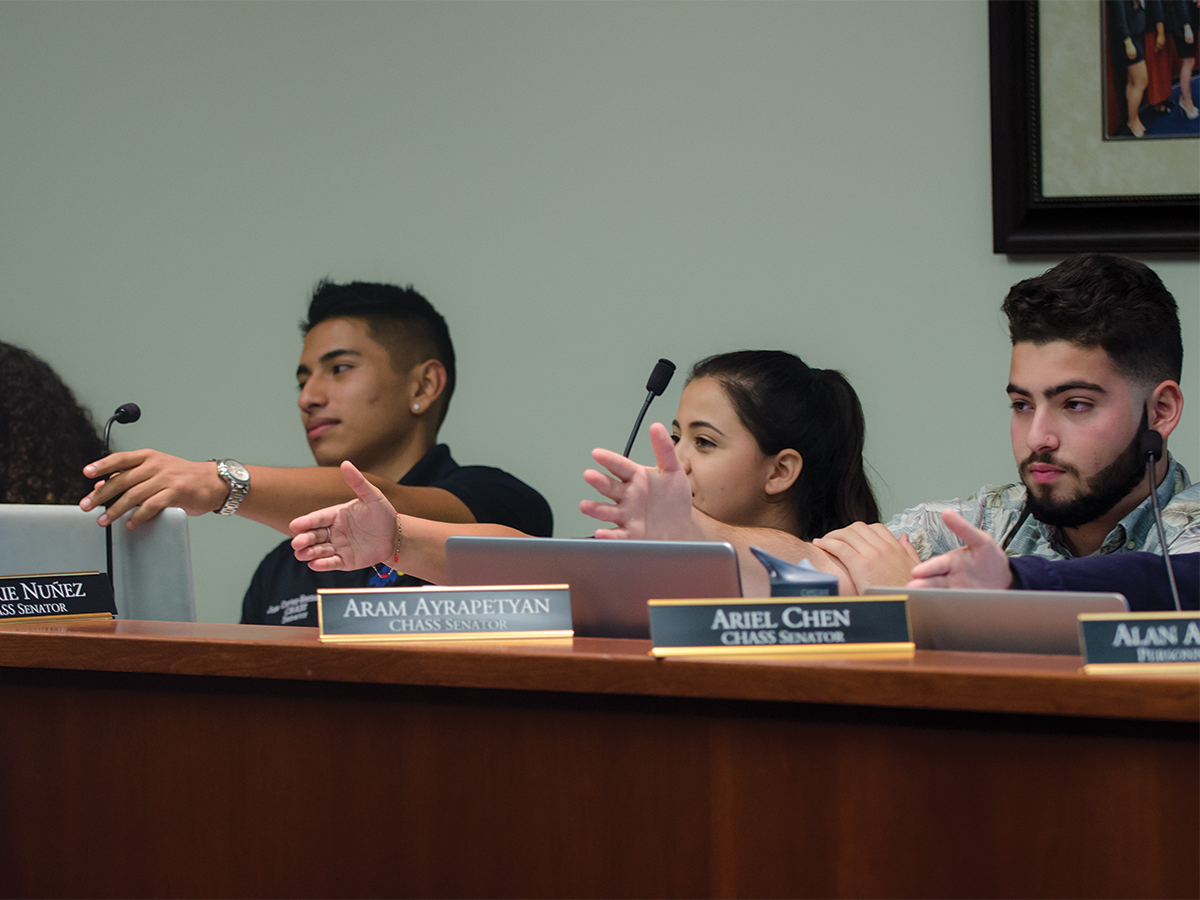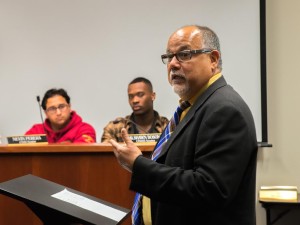
When UC Riverside Chancellor Kim A. Wilcox issued an edict to the Associated Students of UC Riverside (ASUCR) in September ordering that the ASUCR executive director (ED) fall under the complete oversight of Vice Chancellor of Student Affairs (VCSA) James Sandoval with a “dotted line” reporting duty to the ASUCR president, there was no immediate pushback from the Associated Students.
Though, just over one month removed from receiving the edict and a comprehensive audit report which suggested that their former structure (in which the ASUCR president, a student and non-UCR employee, oversaw the ED, a UCR employee), was in “non-compliance with university policy,” ASUCR is in the process of pushing back.
On Friday, Oct. 14, ASUCR President Shafi Karim sent a letter representative of the Associated Students, to Wilcox’s office which includes the following excerpt:
“After hearing from stakeholders and deliberating on the arguments, ASUCR decide (sic) that it does not agree nor accept your decision to change the reporting structure of ASUCR employees. While we do understand your concerns and appreciate your offer to fund 50% (sic) of the salaries and benefits for the ASUCR Executive Director and the Financial Operations Manager, we cannot accept the terms as they would undermine student supervision of our professional staff and threaten the independent decision-making abilities of student leaders.”
The decision not to agree to administrative oversight was finalized after hours of deliberation amongst the senate in a closed session following ASUCR’s senate meeting on Wednesday, Oct. 12. That evening, Sandoval stood affront the horseshoe and responded to concerns raised about the change in oversight and offered insight into the administration’s reasoning, which primarily centered around the “non-compliance” of ASUCR’s reporting structure as originally expressed in the audit.
While the senate’s concerns lie mainly in the threat a change in structure potentially poses to its autonomy, there is a more fundamental dilemma that underlies: The reporting structure denounced by university administrators is one allowed for by the ASUCR constitution. Thus, a change in structure would force a change to ASUCR’s constitutional bylaws. Further, while Wilcox’s call for oversight is based on the structure’s apparent discord with university policy, the senate used the discussion with Sandoval to point to Section 61, Article 10 of the UC-wide Policies Applying to Campus Activities, Organizations and Students (PACAOS), which reads as follows:
“Student governments shall have authority and responsibility over matters that are consistent with their enabling documents such as constitutions and bylaws, and with the University’s purposes for such governments as defined by these Policies and implementing campus regulations.”
“Certainly the senate raised a good point,” said Sandoval in response to the senate’s argument. Though Sandoval also contested, “If the university becomes aware of a conflict in the constitution or bylaws in any university organization we wouldn’t be able to stand by and allow that to persist. Something needs to be adjusted so we can fix what that practice is.”
Nevertheless, the potential threat to autonomy prevails as ASUCR’s larger concern, and is one which proved legitimate enough to Associated Students of UC Berkeley (ASUC) Chief Legal Officer Aleksander Klimek who, hours prior to Sandoval’s appearance at the Oct. 12 senate meeting, drafted a senate resolution entitled “ASUC (Berkeley) In Solidarity WIth the Associated Students of the University of California Riverside.”
On Friday, Oct. 21, the resolution was agreed upon by the ASUC senate and includes the following statement:
“THEREFORE BE IT RESOLVED, that the Associated Students of the University of California:
… Declare that a threat on the autonomy and independence of any student association at a campus of the University of California is a threat on the autonomy of all student associations at all campuses of the University of California, including the ASUC, and thus an attack on all students of the University of California, including UC Berkeley students …”
“I drafted it because I’ve been working with ASUC for a while now and we’ve struggled with our autonomy for quite a while (too),” Klimek told the Highlander. “I decided that it would be good if ASUC took a stance on it.”
Founded as an independent body in 1887, ASUC effectively served as the first form of student governance in the UC system and remained independent until March 18, 1998, when, due in part to declining revenue, “student government negotiated an agreement for the university to oversee ASUC business operations, but with ASUC retaining control of its programs, services, and funds,” per a 2009 article in The Bulletin.
“Over the past decades there has been a systematic exclusion of students from leadership over their own affairs that has continued up until this day,” current ASUC President William Morrow told the Highlander.
Currently, ASUC operates under what Morrow deemed “a unique hybrid model” in which the student government shares joint control with the university, but Morrow acknowledged the existence of a Student Majority Board as effective in “guarantee(ing) student voice and autonomy.”
As it currently stands, ASUCR is the lone fully autonomous student government in the UC system and Klimek acknowledged the potentially harmful effects of them losing their governmental freedom.
“I think that (the) threatening or loss of autonomy really changes how staff work,” shared Klimek. “It’s really important that (student governments) work for students and it’s really important that they provide services to students. Anyone who serves students needs to have that professional support.”
Morrow aligns with Klimek’s concerns, stating, “Every single time the university has taken over roles and functions from the students, the opinions, needs and desires of the students have become increasingly ignored.”
President Karim admitted to being initially hesitant toward the ASUC resolution, based on the fact that it was drafted before a decision was reached by the ASUCR senate. Though, with the decision now official to move forward and challenge the edict, Karim welcomes the act of solidarity from ASUC, stating, “I do appreciate their gesture to stand in solidarity with ASUCR and our reporting structure.”
2015-16 ASUCR President Ashley Harano is familiar with Karim’s current situation. In November of 2015, Wilcox made a similar effort to assume oversight of the ED by issuing a letter to the ASUCR executive cabinet. However, he did so without the inclusion of a comprehensive audit report. While Harano acknowledges that this current dilemma is similar to last year’s, she cites the response from ASUCR being a key difference.

“I think what’s different between last year and this year is that (last year) executive cabinet immediately took action,” says Harano. “Immediately I contacted an attorney (Scott Talkov) that I was familiar with and immediately started thinking about different options.”
What eventually arose from those options was a Memorandum of Understanding (MOU) between ASUCR and administration, which would allow for a dual-reporting structure between the two bodies. However, despite collaborative deliberation between the associated students and administration, Wilcox pulled his signature for what Harano deemed an overall discomfort with ASUCR’s practices — particularly citing the attempt of the ASUCR Finance Committee to backpay 2014-15 ASUCR President Nafi Karim and Executive Vice President Michael Ervin after their censures were ruled unconstitutional by the ASUCR Judicial Branch and independent third party rulings in 2015.*
While President Karim acknowledges that developing a MOU is “a potential compromise (ASUCR) could make,” he admits to being hesitant, as doing so would force ASUCR to amend their constitution.
Overall, Karim cites timing from the Chancellor’s office as a key difference in this year’s dilemma as well as the reason for the apparent delay in response, stating, “Last year when (Wilcox) emailed us, he emailed us during fall quarter, when senate was in session and gave us until November or December … this year he did it over the summer when only ECAB was present.”
Karim also notes he has been in communication with Talkov since this summer, reaching out to him following a meeting with Wilcox to get his professional input.
While Harano remains skeptical of reasons for the delay, she is supportive of ASUCR’s ongoing efforts to push back against the oversight.
“It’s good to hear that they’re working with Talkov again, because I think he’s very capable of helping them in this situation,” stated Harano. “I appreciate that ASUCR is fighting it.”
In short, what can be gathered from the current situation is the following: Who will be overseeing ASUCR’s ED a year from now is entirely unclear. The VCSA’s assumption of oversight, while currently in place, is not finalized and the deliberation process is ongoing. The next step in this process is a face-to-face meeting on Tuesday, Nov. 8 at 4 p.m. between Wilcox, Sandoval and Karim. In addition, Karim has requested to include the executive cabinet, President Pro Tempore Jonathan Li and Senator Aram Araypetyan.
“It wasn’t surprising to me,” Sandoval said of the senate’s decision to oppose the Chancellor’s edict. “It shows a need for further discussion … to ensure that (ASUCR) can function independently.”
What that independency looks like from ASUCR’s perspective is continuing to operate under the reporting structure that is allowed by their constitution. For Sandoval, though, he contests that while no substantial issues have arisen with the ASUCR president overseeing a UCR employee, VCSA oversight at least ensures someone capable will be in that supervisory role.
“An individual that is a student without experience or qualifications is not familiar with policies that govern their behavior and equipped in functioning as a supervisor,” stated Sandoval.
Karim acknowledged that he sees himself as “adequate” in a supervisory position, but conceded, “It depends on the president … I could see where they may not feel comfortable (having a student) supervising.”
Nevertheless, ASUCR will continue to challenge the VCSA in an effort to preserve their autonomy.
“What we were trying to agree on prior to this (assumption of oversight) was to reach a compromise and have a dual reporting,” Karim shared. “As of right now … we just know we do not accept the oversight of VCSA and the ‘dotted line’ reporting structure.”
ASUCR’s next senate meeting will be held in the senate chambers on Wednesday, Nov. 3, beginning at 6 p.m. The meeting will be open to the public.
*Editor’s Note: A previous version of this article failed to acknowledge that the censures of former ASUCR executives Nafi Karim and Michael Ervin were ruled unconstitutional by the ASUCR Judicial Branch and third party rulings. The proper change has since been made. The Highlander regrets the error.








